Hosting a World Cup, in 2031, will help. But U.S. qualification for the coming tournament, in France, is up in the air. And the success of the domestic league is hardly more certain.
Kaleb Geiger played football and baseball at Concordia University in Nebraska, then he went back home to Sedalia, Col. (population: 177), to work in the family business, logging and farming. One Sunday night in January 2021, the 6' 1", 250-pound former high school wrestler went into town for a few beers with friends.
Little did he know, he was being watched.
In the bar that evening was Peter Pasque, general manager of the American Raptors, a rugby team based in the Denver suburb of Glendale, otherwise known as RugbyTown USA. Glendale’s 5,000-seat Infinity Park has hosted international matches, club tournaments and a team at the top pro level, in Major League Rugby. But that franchise, then called the Colorado Raptors, withdrew from MLR in 2020, after COVID-19 killed its third season, and since then the rebranded team has redirected its small budget toward proving true a rugby cliché: that if the U.S. were to convert a fraction of the domestic athletic talent that doesn’t make the NFL or the NBA, it would dominate the world. Over two seasons now the American Raptors have identified converts, trained them and paid them to play against amateur clubs, pro development squads and teams from South America.
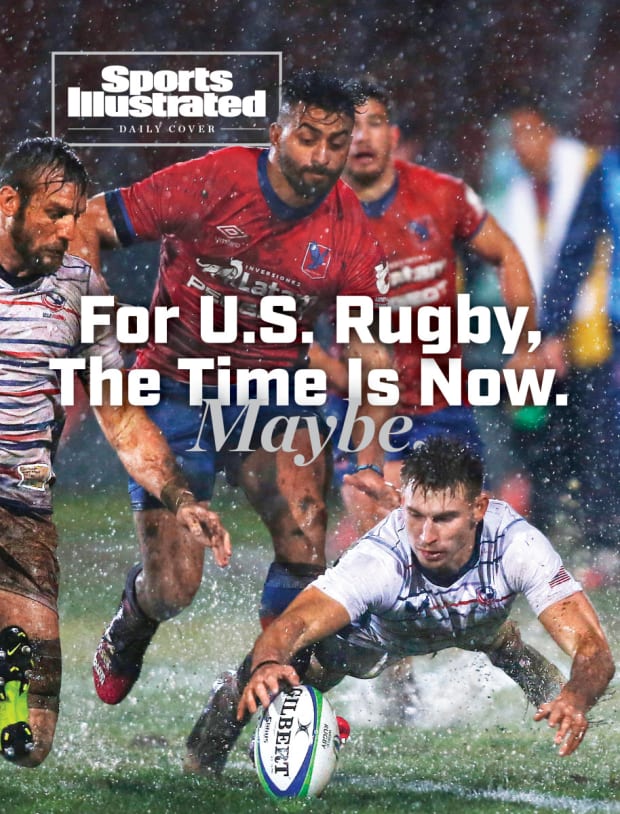
Marcelo Hernandez/Getty Images
Identified how? “We recruit online,” explains Pasque. “It’s as easy as going through college football rosters, looking at heights and weights, then messaging them on Instagram or Twitter. That was how we started during COVID. … [Now] it’s evolved to going to football combines, pro days, making relationships with agents. We’re always looking. Even in airports.”
Even in bars. That night at the Wide Open Saloon in Sedalia, a friend nudged Pasque, pointed at Geiger and said, “Man, that guy looks like he’d be a good rugby player.”
“He does,” Pasque agreed. “I’m gonna go, you know, basically hit on a guy at a bar.”
Pasque made his move, and soon after Geiger joined a Raptors program that today exists apart from MLR but that is still proving something of a talent factory for the four-year-old league. Last July, after playing his new sport for just six months, Geiger signed for MLR’s Rugby New York, and in one of the most specialized and dangerous roles on the field. To play hooker demands strength and technical skill, but Geiger learned it all very swiftly. (In the scrum—the equivalent of American football’s line of scrimmage—hookers bind to two props, big men who support the entire scrum, then use their feet to contest the ball while working as part of one pack of eight forwards pushing against one another.)
To most observers it seems easier to make basketballers and football players into outside backs: attackers who rely on speed and stepping with the ball, who must tackle without it, and who must kick the ball from hand or catch kicks from the other team. Like David Still, once a small-college linebacker, whom the Raptors sent in 2021 to the U.S. squad in sevens (the fast and punishing Olympic form of a game usually played with 15 players each side). But Pasque emphasizes the production of front-row forwards too. Among such Raptors signed into MLR: Pono Davis, a former defensive tackle with SMU, plays prop for the Houston SaberCats; and Tani Tupou, an NFL defensive tackle of two years, does the same for the Seattle Seawolves.
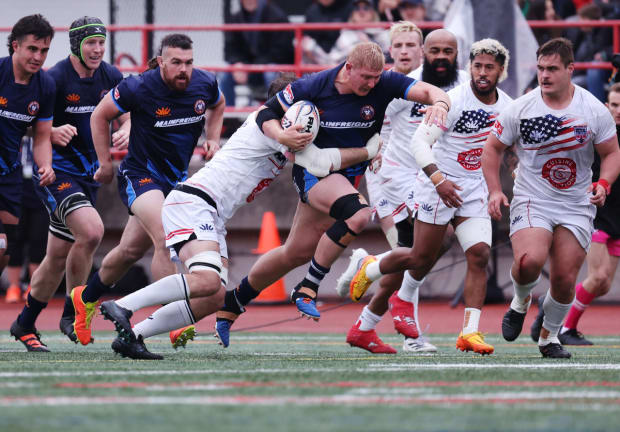
Dustin Satloff/Getty Images for Rugby New York
The Raptors have not yet put anyone into the U.S. 15-a-side squad, the Eagles, but Geiger is seemingly on the verge: He was placed on standby for two recent World Cup qualifiers. In turn, he’s converted at least a few fans himself.
“Where I come from, my brother runs heavy equipment. My cousin’s a power man. My other cousin runs cattle. All my buddies are in some sort of trade. They [didn’t] know rugby’s a thing. Now I got them all [watching] on weekends. They think it’s awesome that one of us got a shot.”
Alas, that shot means that Geiger must live and work in New York.
“I f---ing hate it; it’s massive,” he says of his new home town. “I love the rugby and the guys, the culture that we’re building. But I went from waking up thinking about pastures all day, to this year I wake up and there’s nothing but concrete and people.”
Among a certain set of sports fans, the dream is that Americans will one day go to sleep thinking about football, and then wake up to nothing but rugby. In May that fantasy became a little less fantastical when World Rugby announced that the men’s World Cup, the third-largest sporting event in the world, will be held in the U.S. in 2031, and the women’s tournament two years later.
Ross Young, chief executive of USA Rugby, played a key role in that bid. And now, as he looks ahead, he heralds domestic development efforts, including Rookie Rugby, a noncontact program aimed to reach school kids. Such grassroots work, he says, echoing many voices across the U.S. rugby landscape, must be the bread and butter of the next nine years, alongside efforts to convert talent the way the Raptors do.
Young says he welcomes “players like Kaleb, players like Perry Baker,” a two-time world sevens player of the year who previously played wide receiver for the Eagles; “and people like Alev Kelter,” who was in the U.S. national soccer and ice hockey pipelines (and played both sports at Wisconsin) before joining the U.S. women’s 15s and sevens teams. “But the more we put in at a very, very basic level, engaging kids and turning some of the parents into consumers and fans, that has to be the basis for success through to [the World Cup years], 2031 and ’33.”
Just as crucial: Reaching the next Rugby World Cup, late next summer in France. On Saturday the U.S. suffered an agonizing qualifier defeat by Chile at Infinity Park in Glendale, 31-29 on the day and 52-51 over two games of brutal intensity.
Chile locked up its place in France. The Eagles are not yet out of contention, with a repechage event (which they ought to win against the likes of Portugal, Kenya and probably Hong Kong) to come in the November. But the Eagles have missed only one World Cup, in South Africa in 1995. Made famous by Nelson Mandela’s embrace of a predominantly white sport, that tournament did much to inject rugby into the global sporting conscience. Nine years ahead of hosting its own event, everyone involved in American rugby knows it is time to do the same.
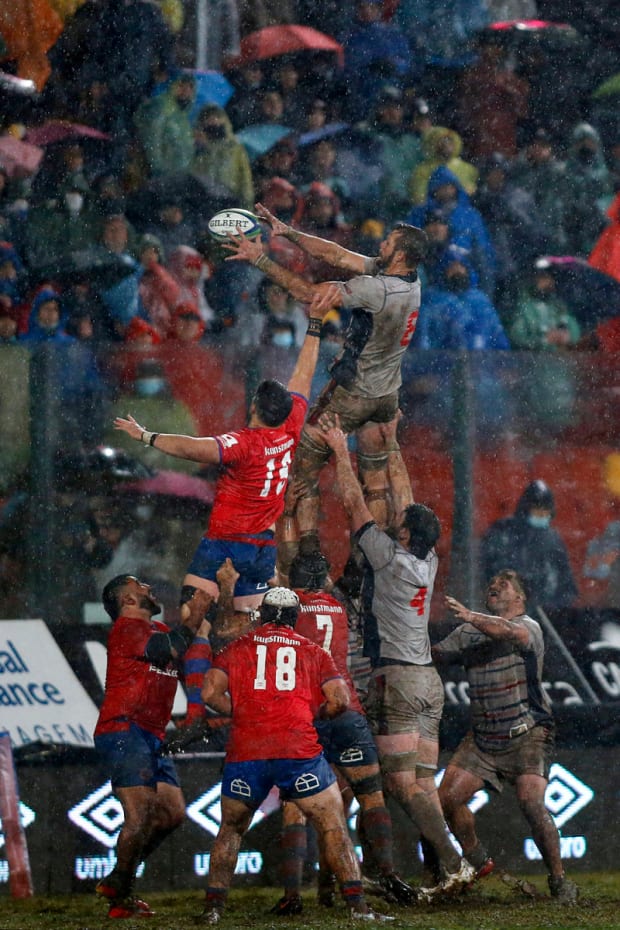
Marcelo Hernandez/Getty Images
The Raptors just want to turbocharge that process, and they don’t want to wait around for some 10-year-old to develop into the next Dan Lyle. In 2021, Pat Guthrie, the team’s director of sports broadcast and development, predicted that within two years the Raptors would produce “five to 10 players for the U.S. national team who will be the standout players. … They’ll just be physically dominant.” He also declared: “Our ambition is to win the Rugby World Cup in 2027.”
His were not empty words, but they surely were ambitious. The pipeline cannot flow at such speed; and anyway, the Raptors face a challenge familiar to anyone and everything surrounding U.S. pro rugby: simple survival.
The Raptors were a founding team in MLR, but their withdrawal in 2020 boiled down to conflicts over the league business model and power struggles centered around two relatively rich team owners: a former Dartmouth rugby player named Errik Anderson, who flourished in biotech and then started the New England Free Jacks; and Adam Gilchrist, an Australian fitness entrepreneur who named his L.A. and Austin franchises the Giltinis and Gilgronis, respectively, after alcoholic drinks that he himself had inspired.
Last December, a month before the preseason, Marcus Calloway, the owner of Rugby ATL and a pillar of the game in the Deep South, died of pancreatic cancer, leaving the new president little time to get her footing. Then the Dallas Jackals, an expansion team, lost all 16 of their games, leading to questions about the depth of talent available. (Franchises in Chicago and St. Louis had long been rumored, but now they seem unlikely to play next season.) And then the big news, in June: Austin and L.A., the top two teams in the West, were disqualified from the playoffs for “failure to cooperate with an investigation conducted by the MLR league office concerning potential violations pertaining to player compensation.” (Read: They’d exceeded the [very small] salary cap. Gilchrist, a controversial figure who has staffed his teams largely with foreign talent, much of it Australian, filed suit, seeking “over $1 million” for “a concerted and underhand campaign of harassment, abuse of process and interference to oust two of the top MLR teams … and to terminate the teams’ MLR license rights in order to sell the licenses to third parties.”)
Not all, though, is doom and gloom. MLR commissioner George Killebrew, a former Dallas Mavericks exec, reports growth in 2022: 70,000 additional tickets sold compared to a year earlier, and Fox Sports One ratings (from three more televised games) that rose 83%. As for the situation with Gilchrist’s two teams: Alex Magleby, the Free Jacks’ CEO, says, “All leagues go through times of change. ... That is no different than MLS in the late ’90s. That is no different than what happened to the NFL throughout its history. … Teams are going to come and go, and teams are going to be temporarily off the books and back in. That is a part of growth, and it should happen in a competitive landscape.”
For all the growth Killebrew cites, crowds remain small (with averages around 2,000 fans) in the now 13-team MLR, and wages modest (typically $10,000 to $20,000 for a 16-game season, though imports can earn more). But those World Cups—the rights for which Anderson, Gilchrist, Killebrew and others all worked together with USA Rugby to win—are a huge prize on the horizon. Quite possibly huge enough to persuade Gilchrist to lay down arms.
Anderson sets the stakes plainly: “We’re gonna have a $4.3 billion World Cup in ’31—more than two times [what a European-hosted Cup might raise].”
Magleby estimates what kind of fan buy-in that will require: “Let’s assume we have 50% [of ticket-buyers] coming from overseas. We’re going to need 1.5 million Americans buying $100 tickets. We’re in a situation [where we need] to start developing that audience.” On the MLR side, Anderson says that will look like some $600 million invested in the league this year, and he hopes to see the sport reach more cities. “We’ll add teams here and there,” he says. “There’s always this tension between how good the player pool is, where it’s from and how you digest growth. I’d like to see us at 20 teams by the World Cup.”
That player pool is a key issue. When it comes to the national team, players born abroad to American parents or with American grandparents can play for the U.S., as can those who complete residency requirements. But still it’s a small group. In the 2022 championship game for MLR, where matchday squads are set at 23 players, New York fielded just seven American-qualified players, Seattle nine. Thirty total players—two starting XVs—came from elsewhere in the world.
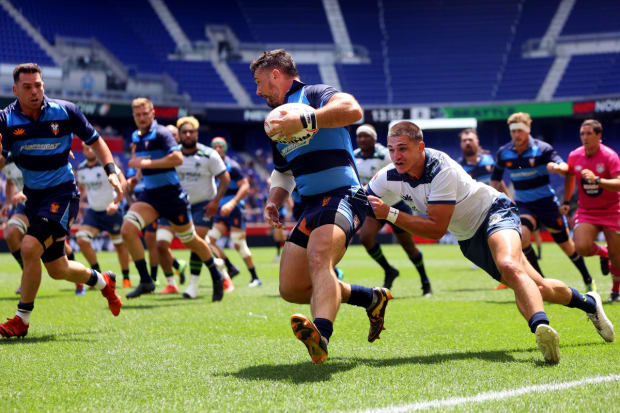
Mike Stobe/Getty Images for Rugby New York
To some, that’s a glaring problem. The U.S. men’s pro league, that camp argues, must predominantly employ American players. How else will the national team grow to challenge the world powers: France, Ireland, South Africa, New Zealand, England and Australia? This was a question that the Glendale contingent asked loudly as it left MLR.
Within the league, unsurprisingly, many disagree. Steve Lewis, the GM of Rugby New York, points out: “MLR is a privately owned, for-profit business concern. Its product is the MLR game. … Its job is not to develop the American national team. There is some synergy, some crossover. That will be a happy consequence for American rugby. But MLR should not be criticized for not doing what the national governing body is charged with doing: stewardship, and the development of the game, the evangelization of the game.”
Evangelization is in fact a key part of Lewis’s world, ministering to schools and clubs in the tri-state area. He also points to the need for the college game to grow, particularly through women’s programs. But the main goal of his development work is to turn up talent—and sell tickets—to benefit Rugby New York.
How much work is there to do? For the recent MLR final, in New Jersey in June, just under 2,000 tickets sold for a stadium, Red Bull Arena, that can hold 12 times that. But those who did attend saw a very good game.
Seattle, champion in 2018 and ’19—but only in these playoffs because of the L.A./Houston disqualifications—scored the first try. Then New York ran in three. Seattle closed to 27–15, then had a try disallowed on an arguable video decision. When Kaleb Geiger came off New York’s bench, the Seawolves were in hunting mode. At a couple of defensive lineouts, a key part of a hooker’s game, Geiger missed his man.
“You just have to think, ‘What are your next three cues that are gonna get the job done? Forget whatever happened,’” he said afterward. “The boys brought me back to the moment, and my next job.”
That next job was a defensive scrum, New York a man short. Geiger bound to his props, crouched, engaged. The pack held. The ball was cleared. With a drop goal from Sam Windsor, of New South Wales, Australia, the MLR Shield was won.
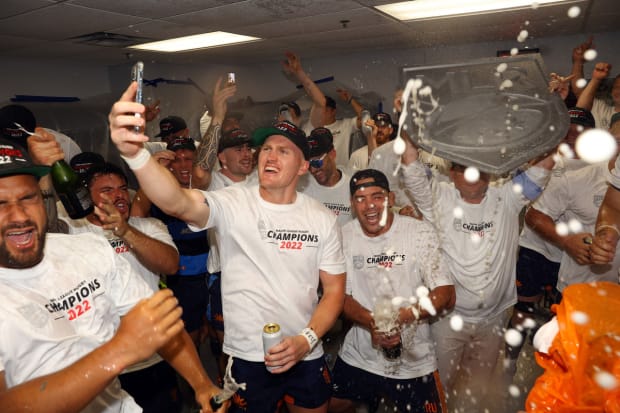
Mike Stobe/Getty Images for Rugby New York
After the game, 11 of New York’s New Zealanders performed a celebratory Maori haka for scrum-half Andy Ellis, who won a World Cup in 2011 and now, at 38, had played his last game. In the locker room, his wife and daughter with him, Ellis delivered a distillation of the rugby spirit, a fitting epilogue for a hugely eventful season and a preview of what American rugby hopes the next decade will bring, before the World Cup comes to town:
“Just think about the group that went out there. We really did represent all the boys and girls who have put a lot of effort into this club. This is a family. We care so much for each other. It’s really deep and it’s really true, and when it’s like that you can start talking about legacy and dynasty.”
Around the room, in various states of battered happiness, sat products of the various corners of American rugby. Geiger, the new convert made by the Raptors in Glendale. Dylan Fawsitt, the Irish-born Eagles hooker who’d taught Geiger so much. Joe Basser, born in New York but raised in Melbourne, a flanker from the age of five, a typical MLR import. Benja Bonasso, another big back-rower, born in Connecticut and raised in Argentina, a hothouse of forward play.
The enormous Nick Civetta (6'8", 260 lbs.), from White Plains, N.Y., picked up rugby at Notre Dame, played for U.S. amateur clubs, won contracts in Europe and last played at Oxford. His fellow second-row forward, Nate Brakeley, found rugby a stage earlier, at St. John’s Preparatory School in Danvers, Mass. He went on to Dartmouth, Cambridge and the U.S. national team.
A quieter American sat off to one side, one foot on an upturned ice bucket, considering a job well done. Chance Wenglewski, an Eagles prop from Oklahoma, was 14, wrestling and playing football, when a friend showed him this sport.
Between them, New York’s seven Americans—five of them Eagles regulars—represented disparate strands of a fiercely competitive, hugely political, often jaggedly divided national game. Most in U.S. rugby agree that those strands must now join together, for nine years of serious work before the World Cup comes to town.
Concluding his farewell speech, Ellis was close to tears.
“Thank you,” he said, “for coming on the journey with me and always having my back. It doesn’t work if we don’t deliver.”
Martin Pengelly is an editor at Guardian U.S. His book He Today That Sheds His Blood With Me: When West Point Rugby Went to War will be published by Godine next year.
• The Unbreakable Bond of Stefon and Trevon Diggs
• Who’s Still Got Milk?
• ‘Oh, You Look Like the Rock’: Finding Rocky’s Family